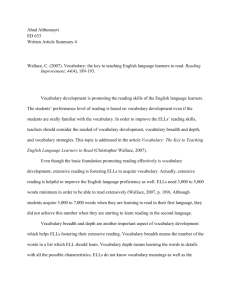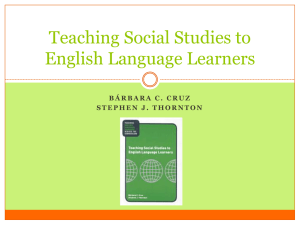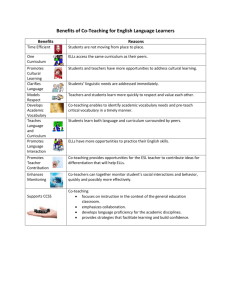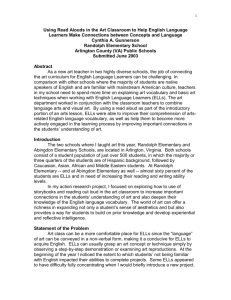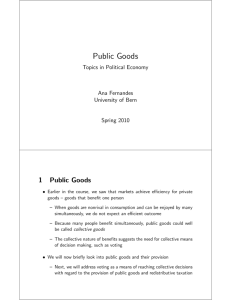Targeted Instruction to Help ELLs Succeed in Content
advertisement
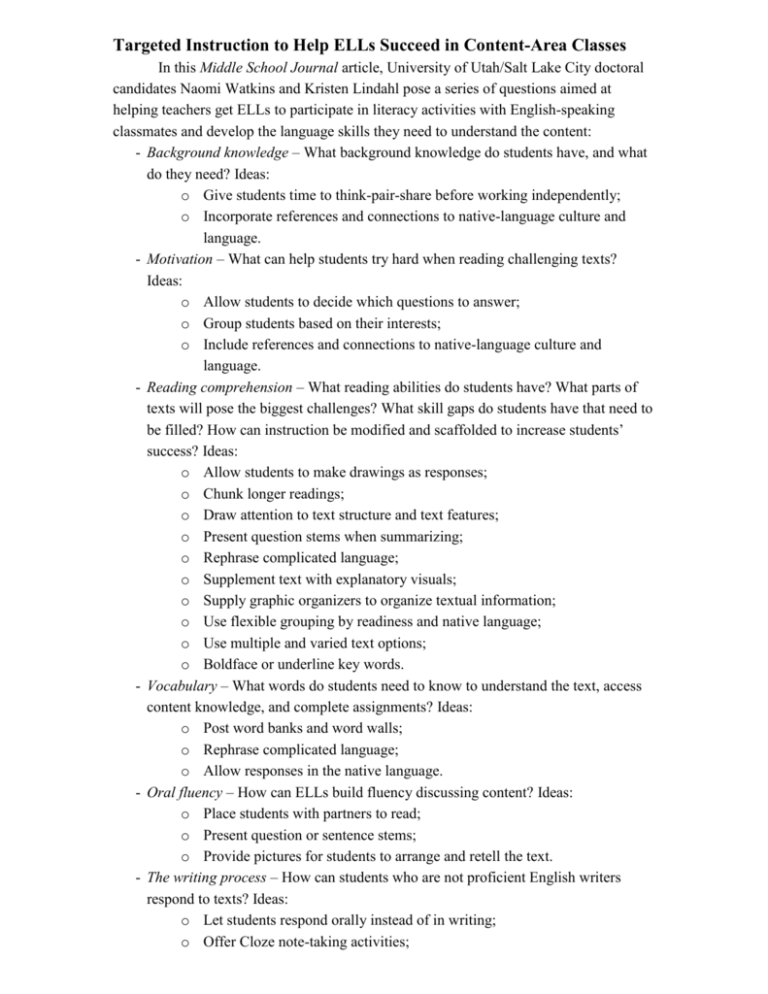
Targeted Instruction to Help ELLs Succeed in Content-Area Classes In this Middle School Journal article, University of Utah/Salt Lake City doctoral candidates Naomi Watkins and Kristen Lindahl pose a series of questions aimed at helping teachers get ELLs to participate in literacy activities with English-speaking classmates and develop the language skills they need to understand the content: - Background knowledge – What background knowledge do students have, and what do they need? Ideas: o Give students time to think-pair-share before working independently; o Incorporate references and connections to native-language culture and language. - Motivation – What can help students try hard when reading challenging texts? Ideas: o Allow students to decide which questions to answer; o Group students based on their interests; o Include references and connections to native-language culture and language. - Reading comprehension – What reading abilities do students have? What parts of texts will pose the biggest challenges? What skill gaps do students have that need to be filled? How can instruction be modified and scaffolded to increase students’ success? Ideas: o Allow students to make drawings as responses; o Chunk longer readings; o Draw attention to text structure and text features; o Present question stems when summarizing; o Rephrase complicated language; o Supplement text with explanatory visuals; o Supply graphic organizers to organize textual information; o Use flexible grouping by readiness and native language; o Use multiple and varied text options; o Boldface or underline key words. - Vocabulary – What words do students need to know to understand the text, access content knowledge, and complete assignments? Ideas: o Post word banks and word walls; o Rephrase complicated language; o Allow responses in the native language. - Oral fluency – How can ELLs build fluency discussing content? Ideas: o Place students with partners to read; o Present question or sentence stems; o Provide pictures for students to arrange and retell the text. - The writing process – How can students who are not proficient English writers respond to texts? Ideas: o Let students respond orally instead of in writing; o Offer Cloze note-taking activities; o Present process steps for challenging tasks such as summarizing; o Present question and sentence stems; o Supply graphic organizers to organize textual information and encourage students to create their own. Using a seventh-grade social studies unit on the ancient Greek city-states of Athens and Sparta as an example, Watkins and Lindahl then give suggestions for effective practices that might be implemented before, during, and after reading • Before reading – Students respond to this prompt in their journals: If you had a time machine and were able to visit the future, what would you tell the people about daily life in our city? What do people do for work? Where do they shop? What do they do in their free time? What other things about life in our city would you tell people living in the future? Students are then asked to think about their purpose for reading: How does life in their city compare to life in ancient Greece? How was life similar and different in Athens than in Sparta? Think-pair-sharing and having ELLs use their native country rather than “our city” would make this even more vivid for them and give them practice using academic English and validate their culture and knowledge. • During reading – Students work in pairs, taking turns being the “reader” and the “coach.” Both read the first paragraph silently, then the reader summarizes the paragraph aloud and the coach asks clarifying questions. They reverse roles on the second paragraph, and so on. When finished with the passage, both students cooperatively summarize the main idea of the text, with particular reference to the purpose-setting questions. For ELLs, oral reading may be stressful, so Watkins and Lindahl recommend taking special care with how students are paired – it could be ELLs working with ELLs or ELLs paired with native English speakers. For summarizing, a particularly challenging task, ELLs might need prompts and question frames to help students zero in on the main content. For unfamiliar vocabulary, a word bank would be helpful. • After reading – Students complete a three-circle Venn diagram comparing life in their own city, Sparta, and Athens and share their product with the class. To support ELLs in this activity, a vocabulary word wall would be especially helpful. The teacher might also add a fourth circle to the Venn diagram for the characteristics of ELLs’ native city or country. ELLs might need extra assistance with vocabulary and fluency for their oral presentations to classmates. While these practices take extra time to prepare and implement, Watkins and Lindahl believe they reduce teacher and student frustration and benefit all students, not just ELLs. “Targeting Content Area Instruction to Meet the Needs of Adolescent English Language Learners” by Naomi Watkins and Kristen Lindahl in Middle School Journal, January 2010 (Vol. 41, #3, p. 23-32), e-link for subscribers only; Watkins is at naomiwatkins@gmail.com and Lindahl at Kristin.schaub@utah.edu.


